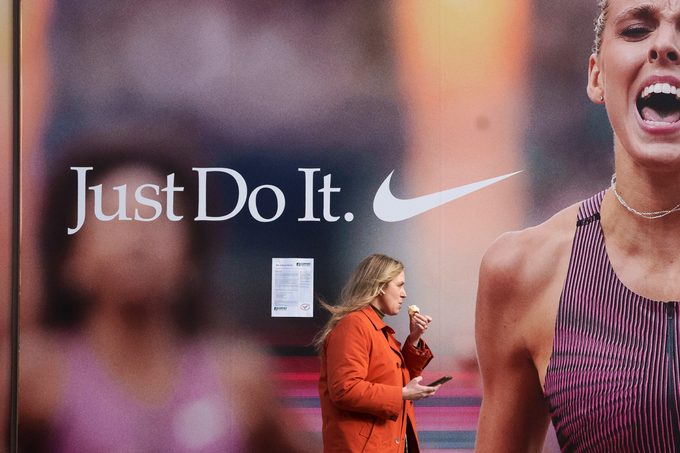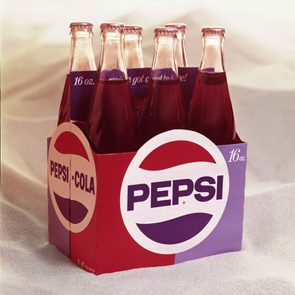Nike’s “Just Do It” origin story is definitely not what you’d expect

Here’s the Surprising Origin of Nike’s “Just Do It” Slogan

In today’s culture, brand logos and slogans are just as ingrained in our minds as basic elementary math. Household name brands feel more like familiar friends than corporate conglomerates, and each has its own distinct identity and role. One of the most well-known company slogans is Nike’s “Just Do It.” This simple three-word phrase that seems to imply that we should all just take the chance on whatever it is we want to do. Motivating, right? Yes, but trust us when we say that the “Just Do It” origin story is a lot more complicated—and disturbing—than that.
Now we’ve got your attention! To dive deeper into its history, Reader’s Digest spoke with marketing and branding experts Arica Espinoza, a senior account manager with Texas Creative, and Ryan Waite, an adjunct marketing professor at Brigham Young University–Hawaii. Read on for all the surprising details behind Nike’s iconic slogan. Trust us: You’ll never look at it the same way again.
Get Reader’s Digest’s Read Up newsletter for more interesting facts, humor, cleaning, travel and tech all week long.
How long has the “Just Do It” slogan been around?
The “Just Do It” slogan feels like it’s been around forever, but it actually only came about in 1988, when ad executive Dan Wieden, co-founder of the firm Wieden+Kennedy, came up with the motivational line. And it was at just the right time for Nike.
“Nike’s ‘Just Do It’ slogan came at a time when the brand was struggling to keep up with Reebok and needed a unifying message that cut across sports, demographics and motivations,” Waite says. “The line worked because it was universal, simple, direct and emotionally loaded. Whether you were training for a marathon or just thinking about taking a walk, it spoke to that moment of hesitation and pushed you through it.”
It’s difficult to quantify exactly how much money the slogan has made for Nike over the years, but it’s estimated that the company’s international sales went from $877 million to $9.2 billion within the decade after the slogan launched. At the time of publication, Nike’s current revenue was sitting at a lofty $47.81 billion.
What is the origin of “Just Do It”?
The “Just Do It” origin story is a pretty dark one. It was inspired by the final words of Gary Gilmore, a convicted murderer who was executed in Utah back in 1977. Gilmore fatally shot two people in two separate robberies over the course of two days in the summer of 1976, attempted to plead insanity during his trial and, while on death row, refused anti-death-penalty advocates’ attempts to save him and instead insisted he wanted to die. According to an eyewitness, before Gilmore was executed by a firing squad, his last words were: “Let’s do it.” Yes, you read that right.
“Wieden admitted the connection later, saying Gilmore’s blunt ‘Let’s do it’ stuck with him,” Waite says. “But obviously that piece of the story was never part of the [Nike] campaign. It stayed quiet for decades.”
Why did Nike think this line would resonate with potential customers?

When Wieden brought the “Just Do It” slogan to Nike, he didn’t reveal his inspiration for it. If he had, we’d bet Nike’s $47.81 billion that they would have never green-lit it. As it was, Nike’s head honchos were divided about the seemingly innocuous slogan (without the creepy backstory) and almost nixed it.
“Some at Nike didn’t think a slogan was necessary,” Waite says. “Even Phil Knight (the co-founder of Nike) reportedly dismissed it. But Wieden fought for it because he believed it could tie their campaign together and speak to everyone, not just athletes. Once it launched, the public response was immediate and deeply personal. People called in to say how it moved them. It didn’t just sell shoes—it gave people a kind of mantra.”
Espinoza echoes Wieden’s sentiment, saying the slogan came to Nike at exactly the right time. “At the time of the slogan’s inception, Nike needed to reach beyond elite athletes and connect with a broader public audience,” Espinoza says. “Dan Wieden was brilliant to hit ’em at the core and humanize our everyday struggles: self-worth, aging, body image, time constraints or simply not knowing where to start.”
How influential has “Just Do It” been?
The “Just Do It” slogan has been an incredibly successful vehicle for Nike to cement its place as an athletic brand, but it also proved to be a groundbreaking moment for advertising as a whole. “What made it so revolutionary was the way it spoke to both ends of the human experience: our deepest self-doubt and our highest potential,” Espinoza says. “It holds emotional complexity even in its catchiness. Do I have what it takes? Am I good enough?What if I fail? This slogan taps into our YOLO moment, telling the impostor syndrome that you’re going to show up anyway.”
She notes that while there was hesitation on Nike’s part initially, Wieden knew the simplicity of the message was its strength. “It gave room for interpretation, adaptation and emotional resonance,” she explains.
How did the public feel when this origin story came to light?
Surprised is probably the right word, both in terms of the public and Nike execs. Needless to say, Nike didn’t exactly publicize the “Just Do It” origin story since it relates to a convicted murderer. The story surfaced through interviews with Wieden and various documentaries on the brand—namely, in the 2009 doc Art & Copy by Doug Pray, as well as a 2015 interview with Design Indaba. Fun fact: As it turns out, 2015 was also the year that Wieden transitioned from a daily role at his agency, Wieden+Kennedy, to a chairman position, though he never formally retired.
“It landed more as a surprising footnote than a scandal,” Waite says. “There wasn’t much controversy, likely because the public had already assigned their own meaning to the phrase. It had been empowering people for 20 years. The connection to Gilmore didn’t change that. The brand had already built such strong emotional equity around the slogan that its strange origin didn’t end up changing anything.”
Why else might you know Gary Gilmore?
Interestingly, Wieden wasn’t the only one who was struck by the convicted murderer’s final moments. Gilmore inspired a total of four songs recorded by different artists, including the Adverts’s “Gary Gilmore’s Eyes,” which was released in 1977, the same year he died. The Police later recorded “Bring on the Night,” which is about the evening before he was executed. The Judy’s has their own Gilmore song, “How’s Gary?” And, finally, Chain Gang produced “Gary Gilmore and the Island of Dr. Moreau.”
Additionally, there was a TV movie called The Executioner’s Song, based on Gilmore’s case. The movie was based on Norman Mailer’s book of the same name.
So now you know!
About the experts
|
Why trust us
At Reader’s Digest, we’re committed to producing high-quality content by writers with expertise and experience in their field in consultation with relevant, qualified experts. We rely on reputable primary sources, including government and professional organizations and academic institutions as well as our writers’ personal experiences where appropriate. For this piece on Nike’s “Just Do It” origin story, Kelly Bryant tapped her experience as a longtime journalist who often covers common curiosities, brands and trending news stories for Reader’s Digest. We verify all facts and data, back them with credible sourcing and revisit them over time to ensure they remain accurate and up to date. Read more about our team, our contributors and our editorial policies.
Sources:
- Ryan Waite, adjunct marketing professor at Brigham Young University–Hawaii and vice president of public affairs at Think Big; interviewed, June 2025
- Arica Espinoza, senior account manager at Texas Creative; interviewed, June 2025
- NPR: “Just Do It: How the iconic Nike tagline built a career for the late Dan Wieden”
- Companies Market Cap: “Revenue for Nike”
- Britannica: “Gary Gilmore”
- The Guardian: “Gary Gilmore Gets his Death Wish”





















